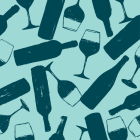Marlborough trademarks new appellation across the globe
Marlborough winemakers have trademarked the new Appellation Marlborough Wine (AMW) certificate in a number of international markets, including North America, Europe and Asia.
The certification mark is designed to distinguish quality producers from bulk blend, and stipulates that 100% of grapes used must be grown in Marlborough and are part of a permitted sustainable viticultural programme. This is in contrast to current labelling laws, which requires only 85% of grapes to come from the origin stated – the further 15% may be sourced from elsewhere.
At the moment, AMW certification is only applicable to Sauvignon Blanc, but may be extended to other grape varieties in the future.
“This is the first step in protecting New Zealand wine that has now become a global icon,” said Ivan Sutherland, chair of AMW and owner of Dog Point Vineyards. “Appellation Marlborough Wine is about protecting the reputation this region has worked hard to build. It provides our global consumers with an assurance they can see and trust.”
Vienna’s Carnuntum region is latest to earn appellation recognition
Also in appellation news this week, the Austrian region of Carnuntum – located to the east of Vienna – has become the country’s latest area to receive official recognition as a Districtus Austriae Controllatus, or DAC.
It becomes the 14th Austrian winegrowing region to adopt regulations protecting the origin of its wines. Austria’s DACs – similar to France’s Appellations d’Origine Controlee (AOCs) – were first established in 2003.
Grape varieties allowed in the Carnuntum DAC include Chardonnay, Weissburgunder (Pinot Blanc) and Gruner Veltliner for whites, and Zweigelt and Blaufrankisch for reds. The blends may contain up to a third of other approved varieties, such as like Sankt Laurent, Cabernet Sauvignon or Merlot. Wines made from other varieties may no longer be labelled with the Carnuntum region name, but may still carry the Niederosterreich designation, of which the area is a part of.
Speaking to Wine Spectator, Dorli Muhr, one of the area’s leading wine producers, said: “Carnuntum has the potential of taking the lead in red wine quality of Austria because we are a small region with a very strong regional spirit between all producers.”
Wine auction market opts for quality over quantity in Q3
Global sales of fine and rare wine at auction fell 16% in the third quarter of 2019, from $70.4 million to $59.9 million. The decline is due largely to the period of July to September traditionally being the quietest time of year for wine auctions, and fewer auctions were conducted over this period in Hong Kong and London compared to the same period last year.
However, while they may have been few and far between, the sales that were held made a big splash. Acker’s September sale saw a half-case of Domaine de la Romanee-Conti Romanee-Conti 2005 go for an eye-watering $111,600, while Hart Davis Hart saw its late-September sale 100% sold with 38% of lots selling above their high estimates and many for record prices.
Elsewhere, the fourth part of Sotheby’s Don Stott collection realised $5.9 million against a pre-sale high estimate of $4.4 million, with even the lots on the low end of the scale achieving aggressive prices – two bottles of Joseph Drouhin Musigny 1978 estimated at $2,000 to $3,000 sold for $8,680, for example.
As Wine Spectator notes, we can expect bigger numbers in the coming months, as the fourth quarter is typically a big one for auction houses. Acker, Christie’s, Hart Davies Hart, Sotheby’s and Zachys all have major sales planned before the year is out.
Case of Bordeaux sent to space to study aging process
A case of Bordeaux wine has been launched into orbit to investigate the impact of weightlessness and space radiation on the aging process.
The bottles – packed into a metal canister for safety – were delivered to the International Space Station on Monday by a Northrop Grumman capsule launched from Virginia.
The experiment – which will last a year – is being conducted by universities in Bordeaux and Bavaria and organised by Luxembourg start-up, Space Cargo Unlimited. It’s the first of six space missions planned by the company that will explore the future of agriculture.
It’s not the first time a wine has been sent into the stratosphere. In 1985, on a French-American collaborative mission, a half bottle of 1975 Chateau Lynch-Bages made it on board, and after being safely returned to Earth was placed on display at the chateau.





